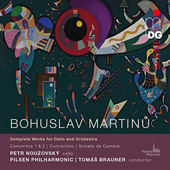
ESSENTIAL RECORDINGS

Concerto for Cello and Orchestra No. 1, H 196
Sonata da Camera for Cello and Orchestra H 238
Concerto for Cello and Orchestra No. 2, H 304
Concertino for Cello, Winds, Percussion and Piano H 143
The grace of Haydn, the opulence of Brahms, and the lyrical expressive warmth of Dvorak all intersect in the Concerto for Cello and Orchestra No. 2, H 304 by
Bohuslav Martinu (1890-1959), in my opinion one of the finest on offer from the 20th century in this genre. Its slow Andante poco Moderato movement in particular
is unquestionably conceived with the unique timbre, resonance and tone colour of the cello in mind. And cellist Petr Nouzovsky's deeply expressive account certainly brings all
of these qualities to the surface. The whole work is characterized by a slightly euphoric outlook. It was written around Christmas time in 1944, when the composer lived in the United States and
enjoyed a more positive artistic and financial situation. Compare this to the Concerto for Cello and Orchestra No. 1, H 196 from 1930, with an equally beautiful
middle slow movement, but endowed with a sad and tragic demeanour. This is a work that was revised and polished many times, something quite out of character for this composer known to
dispense quickly with a commission once done. Both concertos are rewarding listening experiences and raise the question as to why Bohuslav Martinu still remains, to this day, one of the least
proclaimed of the Czech composers.
A sickly child, Bohuslav Martinu spent most of his childhood tucked away in a small room at the top of a church tower overlooking the Czech–Moravian Highlands, where his father earned a living
keeping an eye out for the outbreak of fires in the town below. This may explain why he was later diagnosed as suffering from a form of Asperger Syndrome, which manifests itself as seemingly
anti-social behaviour, and may have contributed to his lack of connections and advancement through the echelons of the music establishment.
The Sonata da Camera for Cello and Orchestra H 238 is diminutive by name only, as it certainly exerts as many technical and expressive demands on the soloist
as do its bigger counterparts on this recording. It turns out that the Concertino for Cello, Winds, Percussion and Piano H 143 was the first concertante piece in
Martinu's entire output. Dating back to 1924 when the composer spent time in Paris, it certainly bears the influence of that time and place, and in moments, even resembles Stravinsky's approach
to orchestration around that time. It's a vibrant and technically demanding work that exemplifies how much can be achieved with a small ensemble of musicians.
There have not been many recordings of these excellent vehicles for the cello, and it certainly is an added bonus to see them all gathered together for the first time on this outstanding MDG
two-disc set.
Jean-Yves Duperron - January 2018